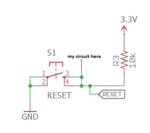TheMartian
Junior Member level 3
Hey
I have 3.3V PIC mcu and other MCU that is 5V.
3.3V PIC MCU has a standard button + 10k resistor to VDD RESET / MCLR circuit.
I want to add a circuit that will take the logic level from 5.0V device (5V or 0V) and let it toggle the 3.3V PIC reset.
So, basically, one device will reset the other device.
I have searched for long time and come up with two solutions:
1.
I think this would work if both logic levels were 0-5V, but in case that 5V is driving transistor with 3.3V on the other side I am afraid that the voltage difference will fry the transistor?
2.
this is a second solution, I am not sure how it works, but I seen it on some board which is reset trough ftdi but I modified it.
IS any of my solutions valid or can you suggest me how to solve my problem?
I have 3.3V PIC mcu and other MCU that is 5V.
3.3V PIC MCU has a standard button + 10k resistor to VDD RESET / MCLR circuit.
I want to add a circuit that will take the logic level from 5.0V device (5V or 0V) and let it toggle the 3.3V PIC reset.
So, basically, one device will reset the other device.
I have searched for long time and come up with two solutions:
1.
I think this would work if both logic levels were 0-5V, but in case that 5V is driving transistor with 3.3V on the other side I am afraid that the voltage difference will fry the transistor?
2.

this is a second solution, I am not sure how it works, but I seen it on some board which is reset trough ftdi but I modified it.
IS any of my solutions valid or can you suggest me how to solve my problem?

